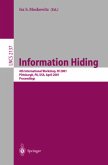This book constitutes the thoroughly refereed post-workshop proceedings of the Third International Workshop on Information Hiding, IH'99, held in Dresden, Germany, in September/October 1999.The 33 revised full papers presented were carefully reviewed and selected from a total of 68 submissions. The dominating topic, dealt with in various contexts, is watermarking. The papers are organized in sections on fundamentals of steganography, paradigms and examples, beyond symmetric steganography; watermarking: proving ownership, detection and decoding, embedding techniques, new designs and applications, improving robustness, software protection; separating private and public information; and stego-engineering.
Now that I have compiled these proceedings, it is a great pleasure to thank all involved. The ?rst thanks go to the scienti?c community interested in hiding infor- tion or in stopping other people doing this. At the initiative of Ross Anderson in 1995, we came together for the ?rst international meeting at IH 96 in C- bridge,andsubsequently met atIH 98in Portland.Our communitynowconsists of about 200 people collaborating around the world and making remarkable progress.Itis ourcommonconvictionthatinthe longrun,muchmoresecurityis achievedbyopendiscussionandpublicselectionofmechanismsandimplemen- tionsthanby securitybyobscurity .Thisisespeciallytrueforlargecommercial systems, and it is most probably also true within the ?eld of information hiding. Trying to hide the design and implementation of hiding mechanisms may be particularly tempting since hiding is an issue anyway. But as shown by the breaks of quite a few digital copy- protection systems within the last few years, security by obscurity may prove not to be commercially viable, at least not in civil societies. The scienti?c community submitted 68 papers to this conference IH 99. This was many more papers than we had expected, and they were of much higher quality than we had dared to hope for. Many thanks to all authors. To cope with this situation, the program committee, consisting of Ross - derson (Cambridge University), David Aucsmith (Intel, Portland, OR), Jean- Paul Linnartz (Philips Research, Eindhoven), Steve Low (University of M- bourne), Ira Moskowitz (US Naval Research Laboratory), Jean-Jacques Quisquater(Universit ecatholiquedeLouvain),MichaelWaidner(IBMResearch, Zurich), and me, decided to ask additional experts to help in the review of - pers.
Now that I have compiled these proceedings, it is a great pleasure to thank all involved. The ?rst thanks go to the scienti?c community interested in hiding infor- tion or in stopping other people doing this. At the initiative of Ross Anderson in 1995, we came together for the ?rst international meeting at IH 96 in C- bridge,andsubsequently met atIH 98in Portland.Our communitynowconsists of about 200 people collaborating around the world and making remarkable progress.Itis ourcommonconvictionthatinthe longrun,muchmoresecurityis achievedbyopendiscussionandpublicselectionofmechanismsandimplemen- tionsthanby securitybyobscurity .Thisisespeciallytrueforlargecommercial systems, and it is most probably also true within the ?eld of information hiding. Trying to hide the design and implementation of hiding mechanisms may be particularly tempting since hiding is an issue anyway. But as shown by the breaks of quite a few digital copy- protection systems within the last few years, security by obscurity may prove not to be commercially viable, at least not in civil societies. The scienti?c community submitted 68 papers to this conference IH 99. This was many more papers than we had expected, and they were of much higher quality than we had dared to hope for. Many thanks to all authors. To cope with this situation, the program committee, consisting of Ross - derson (Cambridge University), David Aucsmith (Intel, Portland, OR), Jean- Paul Linnartz (Philips Research, Eindhoven), Steve Low (University of M- bourne), Ira Moskowitz (US Naval Research Laboratory), Jean-Jacques Quisquater(Universit ecatholiquedeLouvain),MichaelWaidner(IBMResearch, Zurich), and me, decided to ask additional experts to help in the review of - pers.








